The flowering of many plants is not only spectacular, but also fragrant. Such is plumeria. This tropical plant, some species of which are successfully cultivated at room conditions, stands out for its unusual appearance, ease of care and a bright, refined aroma.
Material Content:
Types and description of appearance
Plumeria is a genus of beautifully flowering trees and shrubs of the Courthouse family, native to South America, California, Thailand, and the Caribbean.
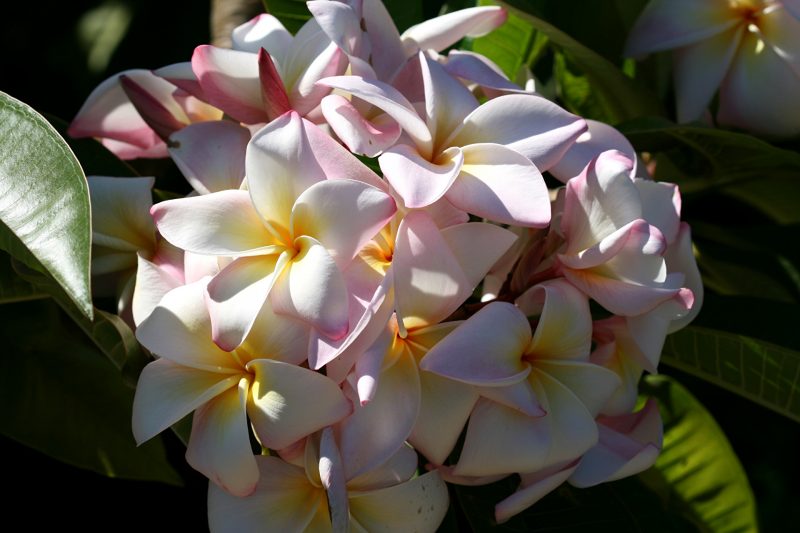
The genus is known by two names. One of them - plumeria - was awarded in honor of the famous French botanist Charles Plumer (17th century) and is more often used among biologists. Another, no less common, sounds like frangipani, or frangipan, and is derived from the name of an Italian nobleman, a perfumer who first used the flowers of this plant to create a new perfume fragrance.
Under natural conditions, plants of this genus are tall, up to 10 m, trees or shrubs.
- Shoots: gray-brown, thick, bare, curved, ending with leaf sockets.
- Leaves: long-leaved, elongated ellipsoid or ovoid, dense, dark green, sometimes with a purple, purple, brown or gray tint. The upper side is covered with a wax coating and slightly darker than the lower. A pronounced central vein divides the leaf blade into two symmetrical halves, each drawn by relief parallel veins extending from the central vein at an angle close to the straight line.
- Flowers: formed on the tops of shoots in the form of racemose inflorescences.Consist of 5 flat petals of an oval or close shape with fused bases and slightly bent inward edges. Petals are painted in shades of white, yellow and red. The classic version assumes the presence of two colors in the color of the flower.
- Fruits: narrow pods of a cylindrical, with pointed peaks, shape. Matured in brown or reddish hues and filled with fairly large flat winged seeds.
Frangipani blooms all summer, effectively distinguishing itself not only with bright large inflorescences, but also with a strong pleasant aroma, most noticeable in the morning and evening hours.
The smell is felt notes of gardenia, citrus and spices, forming an exquisite composition, appreciated by perfumers and cosmetologists.
Several representatives of the genus are cultivated at home, differing in smaller, up to 1.5 m in height, sizes.
The most popular decorative varieties of three types:
- Plumeria is white. It has branching shoots ending in rosettes of elongated obovate leaves with a slight white pubescence on the underside. During flowering, the largest buds collected in fan-shaped brushes appear at the ends of the shoots. The flower petals are slightly bent inward and painted white, with a yellow spot at the base, tone. The aroma of plants of this species is characterized by the presence of almond notes.
- Red plumeria is characterized by a trunk covered with thin bark, and leathery leaves with an elongated oval shape. The culture is also distinguished by large flowers, painted in all shades of red, sometimes with a yellow center. The plant has a different, but equally strong and bright, aroma.
- Obtuse plumeria (obtus) looks very much like white plumeria, differing in miniature (up to 40 cm) and oblong-obovate form of dark green leaves. Another feature is the flowers collected in umbrella inflorescences, and formed by petals slightly bent outward and downward. The species is distinguished by edible fruits.
Growing plumeria from seeds
One of the most common ways to get frangipani at room conditions is to grow from seeds, which can be purchased in specialized stores or collected independently.

In order to prevent the occurrence of diseases, before planting, the seeds are disinfected with one of the following methods:
- with tweezers, each seed 3 times for 2 sec. immersed in a solution of hydrogen peroxide;
- for 2 to 3 hours, soak in a slightly pink solution of potassium permanganate or any fungicide.
Immediately before planting, the seed is soaked for 3 hours in warm water or a solution of any growth stimulator prepared according to the instructions for the preparation. After this, the prepared seeds are dried and begin to sow, which can be done in several ways.
Sowing in soil is carried out as follows:
- A pre-prepared soil mixture (sheet soil, sand and perlite in equal parts) is disinfected by calcining in the oven or spilling with a solution of fungicide or potassium permanganate.
- Soil is poured into small containers, divided into compartments, or mini greenhouses, and sown.
- In the central part, with any convenient object, make a small recess in which the seed is placed with the lionfish up, leaving it on the surface.
- The crops are moistened, after which the container is covered with transparent airtight material to create greenhouse conditions.
Seedlings contain in a warm (25 - 27 ° C) bright place, ventilate daily and remove condensate. If necessary, moisten the substrate. It is important to prevent waterlogging of the soil. This is fraught with rotting seeds.
Subject to the above conditions, the seeds will germinate at least 10 to 12 days later, at most in a month.
It happens that during germination on seedlings there remains a “cap” - the upper part of the scales with lionfish. It inhibits the development of the seedling, so it must be carefully removed, which is convenient to do with tweezers.
Sowing in peat or coconut tablets is an alternative and more convenient method of sowing, avoiding picking. Before use, the tablets are soaked for 10-15 minutes in hot water. Sowing is carried out similarly to planting in the soil, placing 1 seed in each tablet and creating greenhouse conditions for the seedlings.
Planting and germination in water is a more laborious, in comparison with the first, method of sowing, the advantage of which is faster germination of seeds. Planting in the soil are subject to only viable seedlings. To implement such a metol, any porous material (cotton pads or foamiran) and a bowl of warm water will be required.
Read also:crested chlorophytum: care
Germination technology in water is quite simple:
- In a porous material with a sharp object (the tip of a knife or scissors), small holes are made in an amount equal to the number of seeds, placing them at a distance of 0.5 cm.
- Seeds are inserted into the holes so that the lionfish remains above the surface of the material used.
- Warm water is poured into the bowl; fixed seeds are placed on its surface so that their lower part is immersed in water.
- The sowing tank is placed in a warm place.
After about 7 to 10 days, the seeds will hatch. As soon as this happens, they are planted in the ground.
When the seedlings rise to a height of about 6 cm and have at least 2 true leaves, they are dived into separate small pots with drainage holes.
- Drainage (small expanded clay) is laid at the bottom of the containers.
- Soil is poured on top of it: a ready-made purchased substrate (any soil mixture for adeniums or cacti) or a self-made mixture of 2 parts of leaf soil, 1 part of peat with the addition of 1 part of sand and a small (1/2 part) amount of perlite or vermiculite.
- The soil is slightly moistened with a spray bottle.
- In the central part, make a small (up to 5 cm) recess in which a seedling extracted with a lump of earth is placed, deepening the shoot by 2 - 3 cm.
After a dive, the plant is placed in a warm place and darkens for 2 to 3 days. Grown from seeds, plumeria with good care will bloom for 4 - 5 years.
Exotic flower care at home
Plumeria flower is not difficult to grow. Care for it is to create optimal conditions for plant development regarding lighting, air temperature, regular soil moisture, spring-summer feeding and pruning of adult forms.
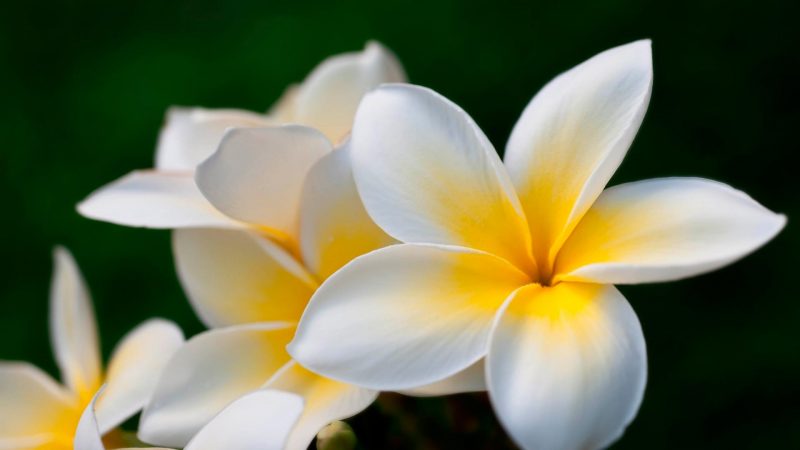
- Plumeria loves the light that it needs for 6 to 7 hours a day. This is especially important in the spring, at the beginning of active growth and during flowering. The leaves of the plant are sensitive to direct sunlight, so the light should be diffused.
- Frangipani is comfortable at ordinary room temperatures. It is permissible to increase them to 26 - 28 ° C, but no more. Being a tropical plant, the flower needs high humidity air.
- Plumeria is watered only with well-maintained (1 - 2 days) water at room temperature. The soil is often moistened and abundant, focusing on the state of the upper layer: it should dry to a depth of not more than 1 cm.
- From spring to flowering, once every 2 weeks, frangipans are fed with complex mineral fertilizers for decorative and deciduous plants. During flowering, mineral additives for flowering plants are added at the same frequency.
- In the first 3 to 4 years of growth, plumeria is transplanted annually. This is necessary due to the rapid growth of the flower, accompanied by depletion of the soil and lack of space for the roots. Adult plants are transplanted only if necessary, with a complete replacement of the soil, shortening the strongly overgrown roots by 1/3 of the length. A transplant of very large specimens is replaced by replacing the topsoil.
It is important to remember that most species of plumeria after flowering rest, which is expressed in a partial discharge of foliage and a slowdown in growth.At this time, the plant needs cooler (14 - 18 ° C) air and rare moisture.
Cropping and shaping the crown
Frangipani - plants rather large for house conditions. Many try to adjust the length of the shoots by pruning them. However, this is far from being achieved by all and not always.

There are several reasons for this:
- Trimming shoots is possible only in an adult mature plant, which occurs no earlier than 4 to 5 years after planting when grown from seeds. A young flower may not survive such an execution.
- In the case of plumeria, pruning only inhibits the growth of shoots and does not stimulate the growth of new ones; therefore, a branched, neat crown is formed for several years, annually conducting a sparing adjustment of the height of the shoots.
To obtain branchy forms, experienced flower growers recommend:
- grow frangipan from cuttings that already have a branch;
- when pruning, lubricate the cut on the shoot with a small amount of a product containing plant growth hormones, for example, cytokinin paste.
Protection against diseases and pests
Plumeria is a plant resistant to pests and diseases. However, its juicy shoots and large leaves attract sucking insects, in particular, spider mites. Its appearance is indicated by the presence of a thin cobweb and small white dots on the underside of the sheet.
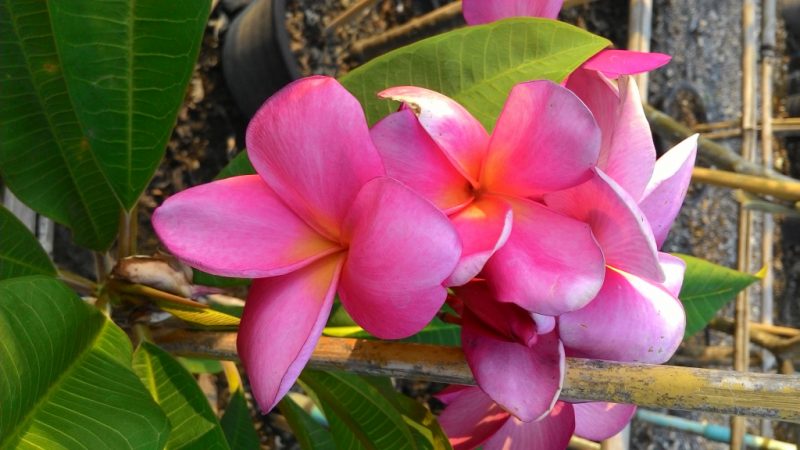
Avoiding the invasion of the tick will allow the plant to be kept in an atmosphere of high humidity and insecticide treatment. The most effective are Fitoverm and Actellik.
The appearance of black dots on the leaves and their subsequent increase in size, ending with the fall of the affected leaves, are signs of the disease (fungus). Blackened leaves are removed, the remaining 2 - 3 times treated with fungicide (Fitosporin, Fundazol, Maxim).
Propagation of plumeria from cuttings
The shoots cut from the plant during pruning can be used to obtain new specimens as cuttings.
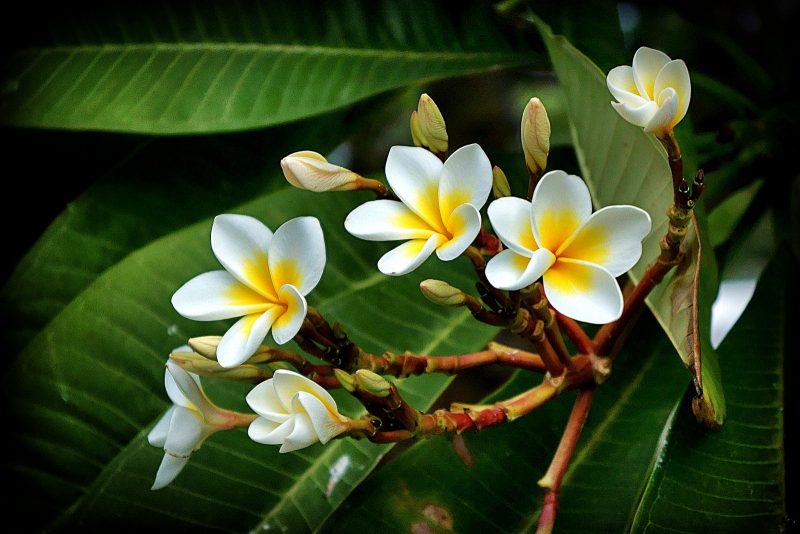
For this:
- The shoots are divided into parts with a length of 15 - 20 cm, conducting the lower cut at an angle, and the upper - straight.
- The prominent milky juice, poisonous to the human body, is washed off under running water and the sections are dried by wetting with a porous cloth or paper.
- The lower (oblique) section is treated with any drug that promotes root growth ("Kornevin", "Heteroauxin"). Top powder activated carbon.
- Prepared cuttings are rooted in the soil, consisting of equal parts of sand, perlite and sheet earth, deepening the lower end of the cuttings by 8 - 10 cm.
- Greenhouse conditions are created for seedlings, providing light, heat and moisture. The presence of lower heating contributes to faster rooting.
After 2.5 - 3 months, the plant will form roots, evidence of this will be the growth of side shoots. The first flowering will come in 2 years.
Possible problems with growing flowers
One of the most common problems encountered when growing plumeria is the failure of the plant to bloom.
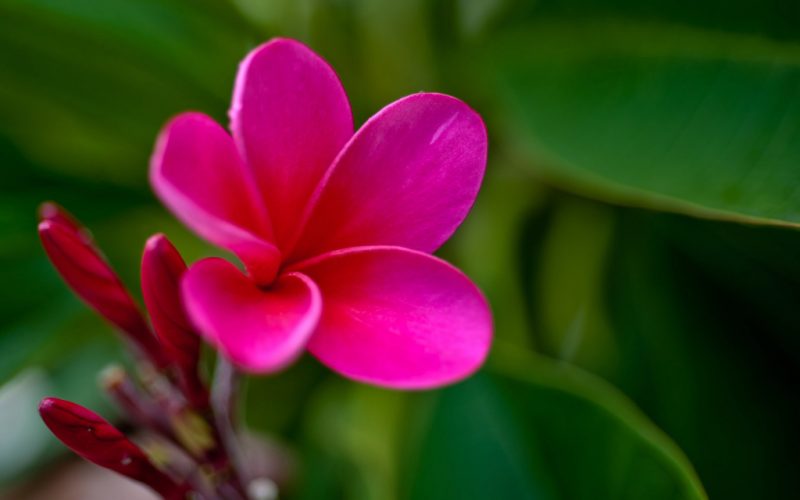
The reasons for this may be:
- the absence of a dormant period due to the content of a flower in winter in a warm (above 18 ° C heat) room
- plentiful autumn watering and feeding after flowering;
- excessive deepening of the root neck of the plant when planting after a dive;
- lack of light and heat;
- growing from seeds harvested from hybrids.
Correction of conditions in most cases leads to a change in the situation for the better. An exception is the cultivation of a flower from the seeds of hybrids. In this case, flowering may never occur.
It is interesting:care Anthurium Andre












